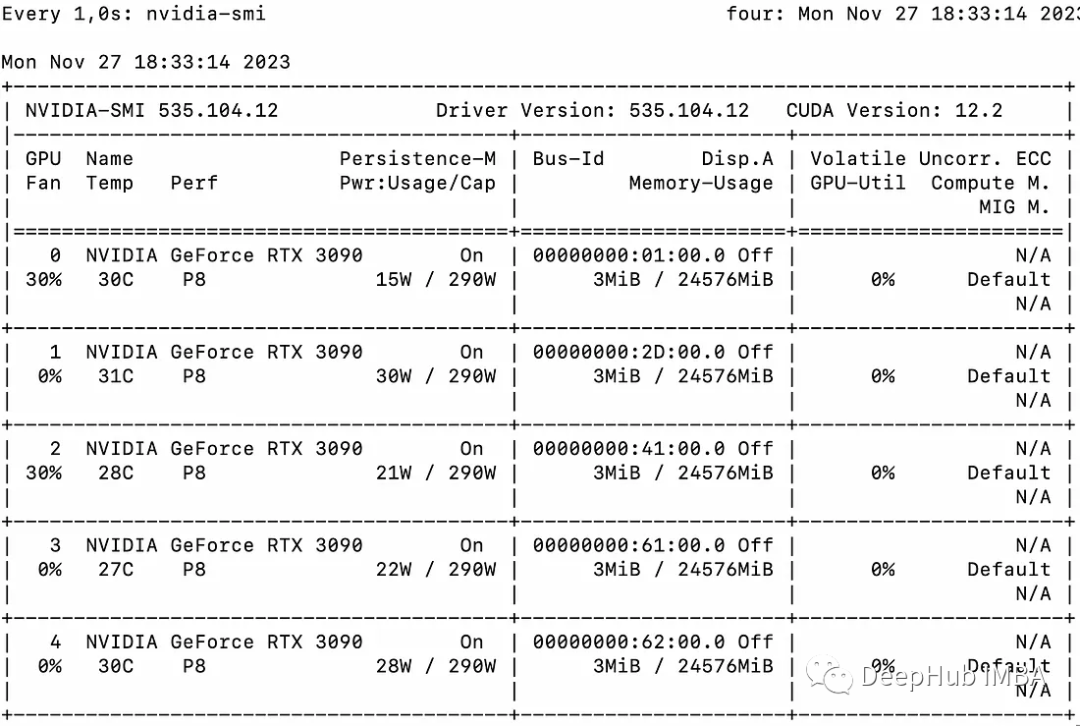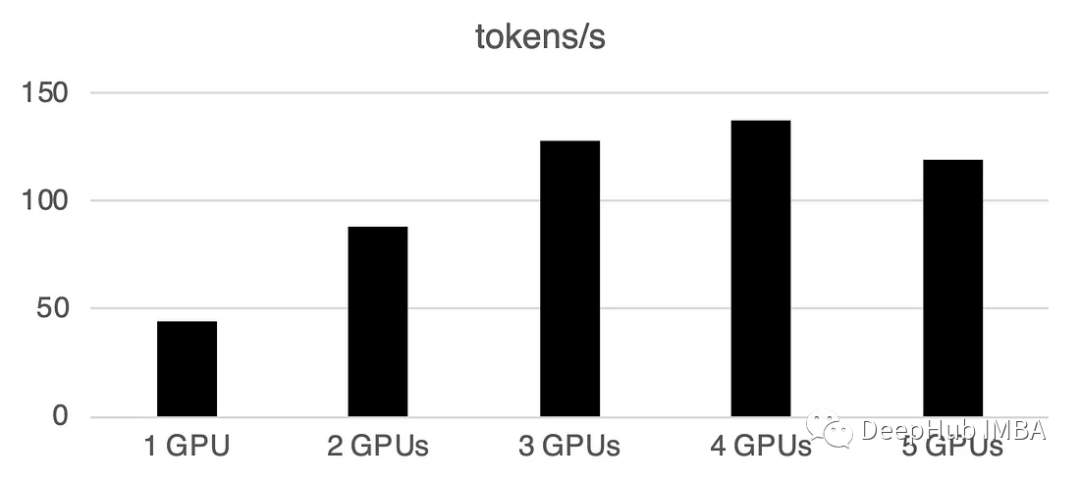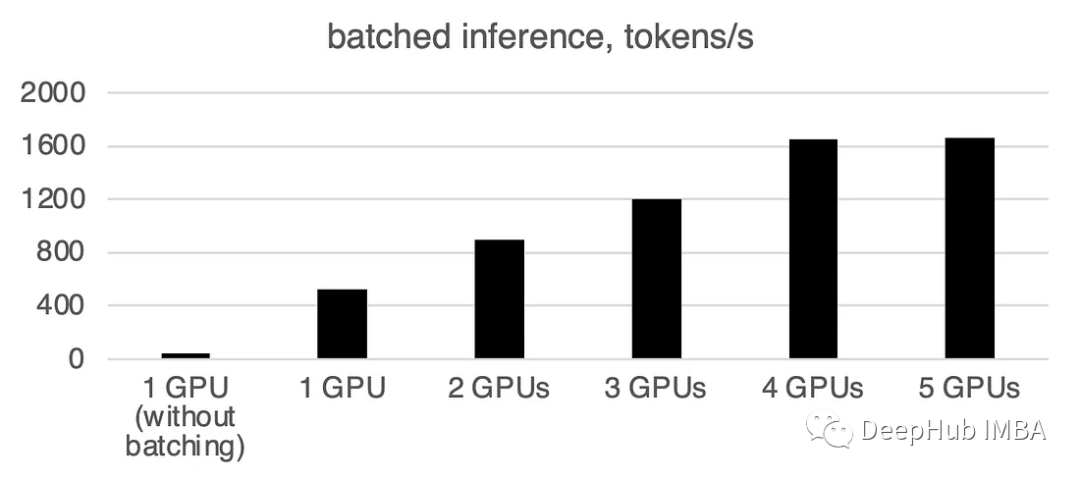Accelerate 라이브러리를 사용하여 여러 GPU에서 LLM 추론
대규모 언어 모델(llm)은 자연어 처리 분야에 혁명을 일으켰습니다. 이러한 모델의 크기와 복잡성이 증가함에 따라 추론을 위한 계산 요구 사항도 크게 증가합니다. 이 문제를 해결하려면 여러 GPU를 활용하는 것이 중요합니다.

따라서 이 기사에서는 주로 Accelerate 라이브러리 소개, 간단한 방법 및 작업 코드 예제, 다중 GPU를 사용한 성능 벤치마킹을 포함하여 여러 GPU에서 동시에 추론을 수행합니다.
이 기사에서는 여러 3090을 사용하여 여러 GPU에서 llama2-7b의 추론을 확장합니다.

기본 예제
먼저 Accelerate를 사용하여 다중 GPU "메시지 전달"을 보여주는 간단한 예를 소개합니다.
from accelerate import Accelerator from accelerate.utils import gather_object accelerator = Accelerator() # each GPU creates a string message=[ f"Hello this is GPU {accelerator.process_index}" ] # collect the messages from all GPUs messages=gather_object(message) # output the messages only on the main process with accelerator.print() accelerator.print(messages)출력은 다음과 같습니다.
['Hello this is GPU 0', 'Hello this is GPU 1', 'Hello this is GPU 2', 'Hello this is GPU 3', 'Hello this is GPU 4']
Multi-GPU inference
다음은 간단한 비배치 추론 방법입니다. 코드는 매우 간단합니다. Accelerate 라이브러리가 이미 많은 작업을 수행했기 때문에 직접 사용할 수 있습니다.
from accelerate import Accelerator from accelerate.utils import gather_object from transformers import AutoModelForCausalLM, AutoTokenizer from statistics import mean import torch, time, json accelerator = Accelerator() # 10*10 Prompts. Source: https://www.penguin.co.uk/articles/2022/04/best-first-lines-in-books prompts_all=["The King is dead. Long live the Queen.","Once there were four children whose names were Peter, Susan, Edmund, and Lucy.","The story so far: in the beginning, the universe was created.","It was a bright cold day in April, and the clocks were striking thirteen.","It is a truth universally acknowledged, that a single man in possession of a good fortune, must be in want of a wife.","The sweat wis lashing oafay Sick Boy; he wis trembling.","124 was spiteful. Full of Baby's venom.","As Gregor Samsa awoke one morning from uneasy dreams he found himself transformed in his bed into a gigantic insect.","I write this sitting in the kitchen sink.","We were somewhere around Barstow on the edge of the desert when the drugs began to take hold.", ] * 10 # load a base model and tokenizer model_path="models/llama2-7b" model = AutoModelForCausalLM.from_pretrained(model_path,device_map={"": accelerator.process_index},torch_dtype=torch.bfloat16, ) tokenizer = AutoTokenizer.from_pretrained(model_path) # sync GPUs and start the timer accelerator.wait_for_everyone() start=time.time() # divide the prompt list onto the available GPUs with accelerator.split_between_processes(prompts_all) as prompts:# store output of generations in dictresults=dict(outputs=[], num_tokens=0) # have each GPU do inference, prompt by promptfor prompt in prompts:prompt_tokenized=tokenizer(prompt, return_tensors="pt").to("cuda")output_tokenized = model.generate(**prompt_tokenized, max_new_tokens=100)[0] # remove prompt from output output_tokenized=output_tokenized[len(prompt_tokenized["input_ids"][0]):] # store outputs and number of tokens in result{}results["outputs"].append( tokenizer.decode(output_tokenized) )results["num_tokens"] += len(output_tokenized) results=[ results ] # transform to list, otherwise gather_object() will not collect correctly # collect results from all the GPUs results_gathered=gather_object(results) if accelerator.is_main_process:timediff=time.time()-startnum_tokens=sum([r["num_tokens"] for r in results_gathered ]) print(f"tokens/sec: {num_tokens//timediff}, time {timediff}, total tokens {num_tokens}, total prompts {len(prompts_all)}")여러 GPU를 사용하면 약간의 통신 오버헤드가 발생합니다. 성능은 4개의 GPU에서 선형적으로 증가하고 이후에는 이는 특정 설정에서 안정적인 경향이 있습니다. 물론 여기의 성능은 모델 크기 및 양자화, 힌트 길이, 생성된 토큰 수 및 샘플링 전략과 같은 많은 매개변수에 따라 달라지므로 일반적인 사례만 논의합니다.
1 GPU: 44 토큰/초, 시간: 225.5초
2 GPU: 초당 88개 토큰 처리, 총 112.9초 시간
3 GPU: 초당 128개 토큰 처리, 총 77.6초
4 GPU: 137 토큰/초, 시간 : 72.7s
5 GPU: 초당 119개 토큰 처리, 총 소요 시간 83.8초

여러 GPU에서 일괄 처리
실제 세계에서는 일괄 추론을 사용하여 작업 속도를 높일 수 있습니다. 위로. 이는 GPU 간의 통신을 줄이고 추론 속도를 높입니다. 단일 데이터가 아닌 일괄 데이터를 모델에 입력하려면 prepare_prompts 함수만 추가하면 됩니다.
from accelerate import Accelerator from accelerate.utils import gather_object from transformers import AutoModelForCausalLM, AutoTokenizer from statistics import mean import torch, time, json accelerator = Accelerator() def write_pretty_json(file_path, data):import jsonwith open(file_path, "w") as write_file:json.dump(data, write_file, indent=4) # 10*10 Prompts. Source: https://www.penguin.co.uk/articles/2022/04/best-first-lines-in-books prompts_all=["The King is dead. Long live the Queen.","Once there were four children whose names were Peter, Susan, Edmund, and Lucy.","The story so far: in the beginning, the universe was created.","It was a bright cold day in April, and the clocks were striking thirteen.","It is a truth universally acknowledged, that a single man in possession of a good fortune, must be in want of a wife.","The sweat wis lashing oafay Sick Boy; he wis trembling.","124 was spiteful. Full of Baby's venom.","As Gregor Samsa awoke one morning from uneasy dreams he found himself transformed in his bed into a gigantic insect.","I write this sitting in the kitchen sink.","We were somewhere around Barstow on the edge of the desert when the drugs began to take hold.", ] * 10 # load a base model and tokenizer model_path="models/llama2-7b" model = AutoModelForCausalLM.from_pretrained(model_path,device_map={"": accelerator.process_index},torch_dtype=torch.bfloat16, ) tokenizer = AutoTokenizer.from_pretrained(model_path) tokenizer.pad_token = tokenizer.eos_token # batch, left pad (for inference), and tokenize def prepare_prompts(prompts, tokenizer, batch_size=16):batches=[prompts[i:i + batch_size] for i in range(0, len(prompts), batch_size)]batches_tok=[]tokenizer.padding_side="left" for prompt_batch in batches:batches_tok.append(tokenizer(prompt_batch, return_tensors="pt", padding='longest', truncatinotallow=False, pad_to_multiple_of=8,add_special_tokens=False).to("cuda") )tokenizer.padding_side="right"return batches_tok # sync GPUs and start the timer accelerator.wait_for_everyone() start=time.time() # divide the prompt list onto the available GPUs with accelerator.split_between_processes(prompts_all) as prompts:results=dict(outputs=[], num_tokens=0) # have each GPU do inference in batchesprompt_batches=prepare_prompts(prompts, tokenizer, batch_size=16) for prompts_tokenized in prompt_batches:outputs_tokenized=model.generate(**prompts_tokenized, max_new_tokens=100) # remove prompt from gen. tokensoutputs_tokenized=[ tok_out[len(tok_in):] for tok_in, tok_out in zip(prompts_tokenized["input_ids"], outputs_tokenized) ] # count and decode gen. tokens num_tokens=sum([ len(t) for t in outputs_tokenized ])outputs=tokenizer.batch_decode(outputs_tokenized) # store in results{} to be gathered by accelerateresults["outputs"].extend(outputs)results["num_tokens"] += num_tokens results=[ results ] # transform to list, otherwise gather_object() will not collect correctly # collect results from all the GPUs results_gathered=gather_object(results) if accelerator.is_main_process:timediff=time.time()-startnum_tokens=sum([r["num_tokens"] for r in results_gathered ]) print(f"tokens/sec: {num_tokens//timediff}, time elapsed: {timediff}, num_tokens {num_tokens}")일괄 처리 속도가 크게 빨라지는 것을 확인할 수 있습니다.
다시 작성해야 할 내용은 다음과 같습니다. 1 GPU: 520개 토큰/초, 시간: 19.2초
두 개의 GPU는 초당 900개 토큰의 컴퓨팅 성능을 가지며 계산 시간은 11.1초입니다
3 GPU: 1205 토큰/초, 시간: 8.2s
4 GPU: 1655 토큰/초, 소요 시간: 6.0초
5 GPU: 1658 토큰/초 카드, 시간: 6.0초

요약
이 글을 기준으로 llama.cpp와 ctransformer는 다중 GPU 추론을 지원하지 않는 것으로 보입니다. 6월에 llama.cpp에 다중 GPU 병합이 있는 것으로 보이지만 공식적인 업데이트는 본 적이 없습니다. , 따라서 당분간 여기에서는 다중 GPU가 지원되지 않는 것으로 확인되었습니다. 여러 GPU를 지원할 수 있다고 확인한 사람이 있으면 메시지를 남겨주세요.
huggingface의 Accelerate 패키지는 여러 GPU를 사용할 수 있는 매우 편리한 옵션을 제공합니다. 추론을 위해 여러 GPU를 사용하면 성능이 크게 향상될 수 있지만 GPU 수가 증가하면 GPU 간 통신 비용이 크게 늘어납니다.
위 내용은 Accelerate 라이브러리를 사용하여 여러 GPU에서 LLM 추론의 상세 내용입니다. 자세한 내용은 PHP 중국어 웹사이트의 기타 관련 기사를 참조하세요!

핫 AI 도구

Undresser.AI Undress
사실적인 누드 사진을 만들기 위한 AI 기반 앱

AI Clothes Remover
사진에서 옷을 제거하는 온라인 AI 도구입니다.

Undress AI Tool
무료로 이미지를 벗다

Clothoff.io
AI 옷 제거제

Video Face Swap
완전히 무료인 AI 얼굴 교환 도구를 사용하여 모든 비디오의 얼굴을 쉽게 바꾸세요!

인기 기사

뜨거운 도구

메모장++7.3.1
사용하기 쉬운 무료 코드 편집기

SublimeText3 중국어 버전
중국어 버전, 사용하기 매우 쉽습니다.

스튜디오 13.0.1 보내기
강력한 PHP 통합 개발 환경

드림위버 CS6
시각적 웹 개발 도구

SublimeText3 Mac 버전
신 수준의 코드 편집 소프트웨어(SublimeText3)

뜨거운 주제
 7888
7888
 15
15
 1649
1649
 14
14
 1410
1410
 52
52
 1301
1301
 25
25
 1247
1247
 29
29
 Bytedance Cutting, SVIP 슈퍼 멤버십 출시: 연간 연속 구독료 499위안, 다양한 AI 기능 제공
Jun 28, 2024 am 03:51 AM
Bytedance Cutting, SVIP 슈퍼 멤버십 출시: 연간 연속 구독료 499위안, 다양한 AI 기능 제공
Jun 28, 2024 am 03:51 AM
이 사이트는 6월 27일에 Jianying이 ByteDance의 자회사인 FaceMeng Technology에서 개발한 비디오 편집 소프트웨어라고 보도했습니다. 이 소프트웨어는 Douyin 플랫폼을 기반으로 하며 기본적으로 플랫폼 사용자를 위한 짧은 비디오 콘텐츠를 제작합니다. Windows, MacOS 및 기타 운영 체제. Jianying은 멤버십 시스템 업그레이드를 공식 발표하고 지능형 번역, 지능형 하이라이트, 지능형 패키징, 디지털 인간 합성 등 다양한 AI 블랙 기술을 포함하는 새로운 SVIP를 출시했습니다. 가격면에서 SVIP 클리핑 월 요금은 79위안, 연간 요금은 599위안(본 사이트 참고: 월 49.9위안에 해당), 월간 연속 구독료는 월 59위안, 연간 연속 구독료는 59위안입니다. 연간 499위안(월 41.6위안)입니다. 또한, 컷 관계자는 "사용자 경험 향상을 위해 기존 VIP에 가입하신 분들도
 Rag 및 Sem-Rag를 사용한 상황 증강 AI 코딩 도우미
Jun 10, 2024 am 11:08 AM
Rag 및 Sem-Rag를 사용한 상황 증강 AI 코딩 도우미
Jun 10, 2024 am 11:08 AM
검색 강화 생성 및 의미론적 메모리를 AI 코딩 도우미에 통합하여 개발자 생산성, 효율성 및 정확성을 향상시킵니다. EnhancingAICodingAssistantswithContextUsingRAGandSEM-RAG에서 번역됨, 저자 JanakiramMSV. 기본 AI 프로그래밍 도우미는 자연스럽게 도움이 되지만, 소프트웨어 언어에 대한 일반적인 이해와 소프트웨어 작성의 가장 일반적인 패턴에 의존하기 때문에 가장 관련성이 높고 정확한 코드 제안을 제공하지 못하는 경우가 많습니다. 이러한 코딩 도우미가 생성한 코드는 자신이 해결해야 할 문제를 해결하는 데 적합하지만 개별 팀의 코딩 표준, 규칙 및 스타일을 따르지 않는 경우가 많습니다. 이로 인해 코드가 애플리케이션에 승인되기 위해 수정되거나 개선되어야 하는 제안이 나타나는 경우가 많습니다.
 7가지 멋진 GenAI 및 LLM 기술 인터뷰 질문
Jun 07, 2024 am 10:06 AM
7가지 멋진 GenAI 및 LLM 기술 인터뷰 질문
Jun 07, 2024 am 10:06 AM
AIGC에 대해 자세히 알아보려면 다음을 방문하세요. 51CTOAI.x 커뮤니티 https://www.51cto.com/aigc/Translator|Jingyan Reviewer|Chonglou는 인터넷 어디에서나 볼 수 있는 전통적인 문제 은행과 다릅니다. 고정관념에서 벗어나 생각해야 합니다. LLM(대형 언어 모델)은 데이터 과학, 생성 인공 지능(GenAI) 및 인공 지능 분야에서 점점 더 중요해지고 있습니다. 이러한 복잡한 알고리즘은 인간의 기술을 향상시키고 많은 산업 분야에서 효율성과 혁신을 촉진하여 기업이 경쟁력을 유지하는 데 핵심이 됩니다. LLM은 자연어 처리, 텍스트 생성, 음성 인식 및 추천 시스템과 같은 분야에서 광범위하게 사용될 수 있습니다. LLM은 대량의 데이터로부터 학습하여 텍스트를 생성할 수 있습니다.
 미세 조정을 통해 LLM이 실제로 새로운 것을 배울 수 있습니까? 새로운 지식을 도입하면 모델이 더 많은 환각을 생성할 수 있습니다.
Jun 11, 2024 pm 03:57 PM
미세 조정을 통해 LLM이 실제로 새로운 것을 배울 수 있습니까? 새로운 지식을 도입하면 모델이 더 많은 환각을 생성할 수 있습니다.
Jun 11, 2024 pm 03:57 PM
LLM(대형 언어 모델)은 대규모 텍스트 데이터베이스에서 훈련되어 대량의 실제 지식을 습득합니다. 이 지식은 매개변수에 내장되어 필요할 때 사용할 수 있습니다. 이러한 모델에 대한 지식은 훈련이 끝나면 "구체화"됩니다. 사전 훈련이 끝나면 모델은 실제로 학습을 중단합니다. 모델을 정렬하거나 미세 조정하여 이 지식을 활용하고 사용자 질문에 보다 자연스럽게 응답하는 방법을 알아보세요. 그러나 때로는 모델 지식만으로는 충분하지 않을 때도 있으며, 모델이 RAG를 통해 외부 콘텐츠에 접근할 수 있더라도 미세 조정을 통해 모델을 새로운 도메인에 적응시키는 것이 유익한 것으로 간주됩니다. 이러한 미세 조정은 인간 주석 작성자 또는 기타 LLM 생성자의 입력을 사용하여 수행됩니다. 여기서 모델은 추가적인 실제 지식을 접하고 이를 통합합니다.
 당신이 모르는 머신러닝의 5가지 학교
Jun 05, 2024 pm 08:51 PM
당신이 모르는 머신러닝의 5가지 학교
Jun 05, 2024 pm 08:51 PM
머신 러닝은 명시적으로 프로그래밍하지 않고도 컴퓨터가 데이터로부터 학습하고 능력을 향상시킬 수 있는 능력을 제공하는 인공 지능의 중요한 분야입니다. 머신러닝은 이미지 인식, 자연어 처리, 추천 시스템, 사기 탐지 등 다양한 분야에서 폭넓게 활용되며 우리의 삶의 방식을 변화시키고 있습니다. 기계 학습 분야에는 다양한 방법과 이론이 있으며, 그 중 가장 영향력 있는 5가지 방법을 "기계 학습의 5개 학교"라고 합니다. 5개 주요 학파는 상징학파, 연결주의 학파, 진화학파, 베이지안 학파, 유추학파이다. 1. 상징주의라고도 알려진 상징주의는 논리적 추론과 지식 표현을 위해 상징을 사용하는 것을 강조합니다. 이 사고 학교는 학습이 기존을 통한 역연역 과정이라고 믿습니다.
 대형 모델에 대한 새로운 과학적이고 복잡한 질문 답변 벤치마크 및 평가 시스템을 제공하기 위해 UNSW, Argonne, University of Chicago 및 기타 기관이 공동으로 SciQAG 프레임워크를 출시했습니다.
Jul 25, 2024 am 06:42 AM
대형 모델에 대한 새로운 과학적이고 복잡한 질문 답변 벤치마크 및 평가 시스템을 제공하기 위해 UNSW, Argonne, University of Chicago 및 기타 기관이 공동으로 SciQAG 프레임워크를 출시했습니다.
Jul 25, 2024 am 06:42 AM
편집자 |ScienceAI 질문 응답(QA) 데이터 세트는 자연어 처리(NLP) 연구를 촉진하는 데 중요한 역할을 합니다. 고품질 QA 데이터 세트는 모델을 미세 조정하는 데 사용될 수 있을 뿐만 아니라 LLM(대형 언어 모델)의 기능, 특히 과학적 지식을 이해하고 추론하는 능력을 효과적으로 평가하는 데에도 사용할 수 있습니다. 현재 의학, 화학, 생물학 및 기타 분야를 포괄하는 과학적인 QA 데이터 세트가 많이 있지만 이러한 데이터 세트에는 여전히 몇 가지 단점이 있습니다. 첫째, 데이터 형식이 비교적 단순하고 대부분이 객관식 질문이므로 평가하기 쉽지만 모델의 답변 선택 범위가 제한되고 모델의 과학적 질문 답변 능력을 완전히 테스트할 수 없습니다. 이에 비해 개방형 Q&A는
 SOTA 성능, 샤먼 다중 모드 단백질-리간드 친화성 예측 AI 방법, 최초로 분자 표면 정보 결합
Jul 17, 2024 pm 06:37 PM
SOTA 성능, 샤먼 다중 모드 단백질-리간드 친화성 예측 AI 방법, 최초로 분자 표면 정보 결합
Jul 17, 2024 pm 06:37 PM
Editor | KX 약물 연구 및 개발 분야에서 단백질과 리간드의 결합 친화도를 정확하고 효과적으로 예측하는 것은 약물 스크리닝 및 최적화에 매우 중요합니다. 그러나 현재 연구에서는 단백질-리간드 상호작용에서 분자 표면 정보의 중요한 역할을 고려하지 않습니다. 이를 기반으로 Xiamen University의 연구자들은 처음으로 단백질 표면, 3D 구조 및 서열에 대한 정보를 결합하고 교차 주의 메커니즘을 사용하여 다양한 양식 특징을 비교하는 새로운 다중 모드 특징 추출(MFE) 프레임워크를 제안했습니다. 조정. 실험 결과는 이 방법이 단백질-리간드 결합 친화도를 예측하는 데 있어 최첨단 성능을 달성한다는 것을 보여줍니다. 또한 절제 연구는 이 프레임워크 내에서 단백질 표면 정보와 다중 모드 기능 정렬의 효율성과 필요성을 보여줍니다. 관련 연구는 "S"로 시작된다
 SK하이닉스가 8월 6일 12단 HBM3E, 321고 NAND 등 AI 관련 신제품을 선보인다.
Aug 01, 2024 pm 09:40 PM
SK하이닉스가 8월 6일 12단 HBM3E, 321고 NAND 등 AI 관련 신제품을 선보인다.
Aug 01, 2024 pm 09:40 PM
1일 본 사이트 소식에 따르면 SK하이닉스는 오늘(1일) 블로그 게시물을 통해 8월 6일부터 8일까지 미국 캘리포니아주 산타클라라에서 열리는 글로벌 반도체 메모리 서밋 FMS2024에 참가한다고 밝혔다. 많은 새로운 세대의 제품. 인공지능 기술에 대한 관심이 높아지고 있는 가운데, 이전에는 주로 NAND 공급업체를 대상으로 한 플래시 메모리 서밋(FlashMemorySummit)이었던 미래 메모리 및 스토리지 서밋(FutureMemoryandStorage) 소개를 올해는 미래 메모리 및 스토리지 서밋(FutureMemoryandStorage)으로 명칭을 변경했습니다. DRAM 및 스토리지 공급업체와 더 많은 플레이어를 초대하세요. SK하이닉스가 지난해 출시한 신제품




